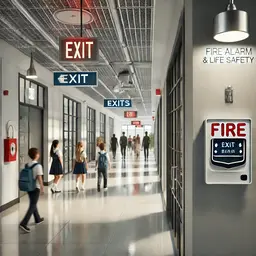
Safety in educational institutions is a top priority, with the lives of students, staff, and faculty at stake. Fire alarm and life safety systems are critical components in ensuring that schools, colleges, and universities provide a secure environment conducive to learning. These systems are not only a regulatory necessity but also a moral obligation to safeguard lives and property. In this article, we explore the importance of fire alarm and life safety systems in the education industry, their benefits, and best practices for implementation and maintenance.
Why Fire Alarm and Life Safety Systems Are Essential in Schools
- Protection of Lives
Educational institutions often house large populations, including young children who may lack the ability to respond swiftly to emergencies. Fire alarm systems provide early warnings, giving staff and students valuable time to evacuate safely. Life safety systems, such as emergency lighting and exit signage, guide individuals during emergencies, preventing chaos and confusion. - Compliance with Regulations
Schools and universities are required to adhere to strict fire safety codes, such as those outlined by the National Fire Protection Association (NFPA) and local building regulations. Non-compliance can lead to legal penalties, reputational damage, and increased risks of accidents. Fire alarm systems ensure institutions meet these standards. - Asset and Infrastructure Protection
Educational institutions often house valuable assets, such as computers, lab equipment, and historical documents. Fire suppression systems integrated with fire alarms help protect these assets from fire damage, minimizing financial losses and ensuring continuity of operations. - Support for Emergency Response
Fire alarm systems integrated with mass notification systems (MNS) and emergency communication tools enable faster responses from fire departments and first responders. These systems provide real-time updates on fire locations and building layouts, allowing emergency personnel to act quickly and effectively. - Fostering Trust Among Parents and the Community
A well-maintained fire alarm and life safety system reassures parents and the broader community that the institution prioritizes the safety of students and staff. This trust is crucial in building the reputation of an educational institution.
Key Components of Fire Alarm and Life Safety Systems in Schools
- Fire Alarm Control Panel (FACP)
The heart of any fire alarm system, the FACP receives signals from detection devices and activates alarms. Modern panels also communicate with monitoring centers and emergency services for immediate response. - Smoke and Heat Detectors
These devices detect early signs of fire and are strategically placed in classrooms, libraries, cafeterias, and hallways. Heat detectors are particularly useful in kitchens and boiler rooms, where smoke may not always be present initially. - Pull Stations
Manual pull stations, typically located near exits, allow individuals to activate fire alarms if they spot a fire before detection devices do. - Notification Appliances
Audible and visual alarms, such as strobes and horns, alert occupants to evacuate. In schools, voice evacuation systems provide clear, calm instructions to avoid panic. - Emergency Lighting and Exit Signage
During power outages or emergencies, emergency lighting ensures visibility in hallways and staircases. Illuminated exit signs guide occupants to the nearest safe exits. - Fire Suppression Systems
Sprinklers, clean agent systems, and fire extinguishers help control or extinguish fires, minimizing damage and allowing safe evacuations. - Mass Notification Systems (MNS)
MNS allow administrators to communicate with students and staff during emergencies, providing instructions or updates via intercoms, text messages, or digital signage.
Challenges in Implementing Fire and Life Safety Systems in Schools
- Aging Infrastructure
Many schools operate in older buildings that lack modern fire safety systems. Retrofitting these systems can be costly and complex but is necessary for compliance and safety. - Budget Constraints
Limited funding can make it challenging for schools to install and maintain comprehensive fire and life safety systems. Administrators must prioritize safety in budgeting and seek grants or subsidies when possible. - False Alarms
In schools, false alarms caused by pranks or malfunctioning devices can disrupt learning and create unnecessary panic. Regular maintenance and education can help mitigate this issue. - Student and Staff Training
Even with the best systems in place, effective evacuations depend on regular fire drills and training sessions. Ensuring all individuals understand evacuation procedures is crucial.
Benefits of Fire Alarm and Life Safety Systems in Education
- Early Detection Saves Lives
Quick detection of smoke or heat allows schools to evacuate buildings before fire spreads, significantly reducing injuries and fatalities. - Minimized Property Damage
Fire suppression systems work in tandem with fire alarms to control fires at their source, protecting buildings and assets from extensive damage. - Enhanced Emergency Preparedness
Integrated systems ensure schools are prepared for a range of emergencies, from fires to chemical spills, by providing clear communication and safe evacuation routes. - Peace of Mind for All Stakeholders
Knowing that a school has robust fire and life safety systems in place gives students, staff, parents, and the community peace of mind. - Long-Term Cost Savings
While the upfront costs of installation may be high, well-maintained systems reduce the financial impact of fire incidents, including insurance claims and repair costs.
Best Practices for Fire and Life Safety in Schools
- Conduct Regular Risk Assessments
Periodically evaluate the building’s layout, occupancy levels, and fire hazards to identify vulnerabilities and ensure compliance with safety standards. - Install Systems Tailored to the School’s Needs
Choose fire alarm and life safety systems designed for the unique challenges of educational institutions. For example, systems with voice evacuation features may be more effective in schools with young children. - Schedule Routine Maintenance
Inspect and test fire alarms, detectors, and suppression systems regularly to ensure they remain operational. - Integrate with Modern Technologies
Leverage IoT-enabled devices and cloud-based monitoring systems for real-time alerts and improved maintenance tracking. - Train Students and Staff
Conduct regular fire drills and training sessions to familiarize everyone with evacuation procedures and system operations. - Work with Trusted Providers
Partner with experienced fire safety companies to design, install, and maintain systems that meet regulatory requirements and the school’s specific needs.
The Future of Fire Safety in Education
As technology advances, fire alarm and life safety systems are becoming smarter and more efficient. Emerging trends include:
- AI-Driven Detection
Artificial intelligence can analyze data from sensors to identify fires faster and reduce false alarms. - IoT Integration
Connected devices allow for real-time monitoring and predictive maintenance, ensuring systems are always operational. - Cloud-Based Monitoring
Cloud platforms enable remote access to fire safety systems, providing administrators with greater control and visibility. - Sustainable Solutions
Eco-friendly fire suppression systems are gaining popularity, reducing environmental impact without compromising safety.
Conclusion
Fire alarm and life safety systems are indispensable for ensuring the safety of students, staff, and assets in educational institutions. From early detection and evacuation guidance to compliance and community trust, these systems play a vital role in creating a secure learning environment. By investing in modern, well-maintained systems and fostering a culture of preparedness, schools can protect their communities and focus on what matters most—education.
Need help upgrading your school’s fire safety systems? Contact us today to explore customized solutions for your institution.


